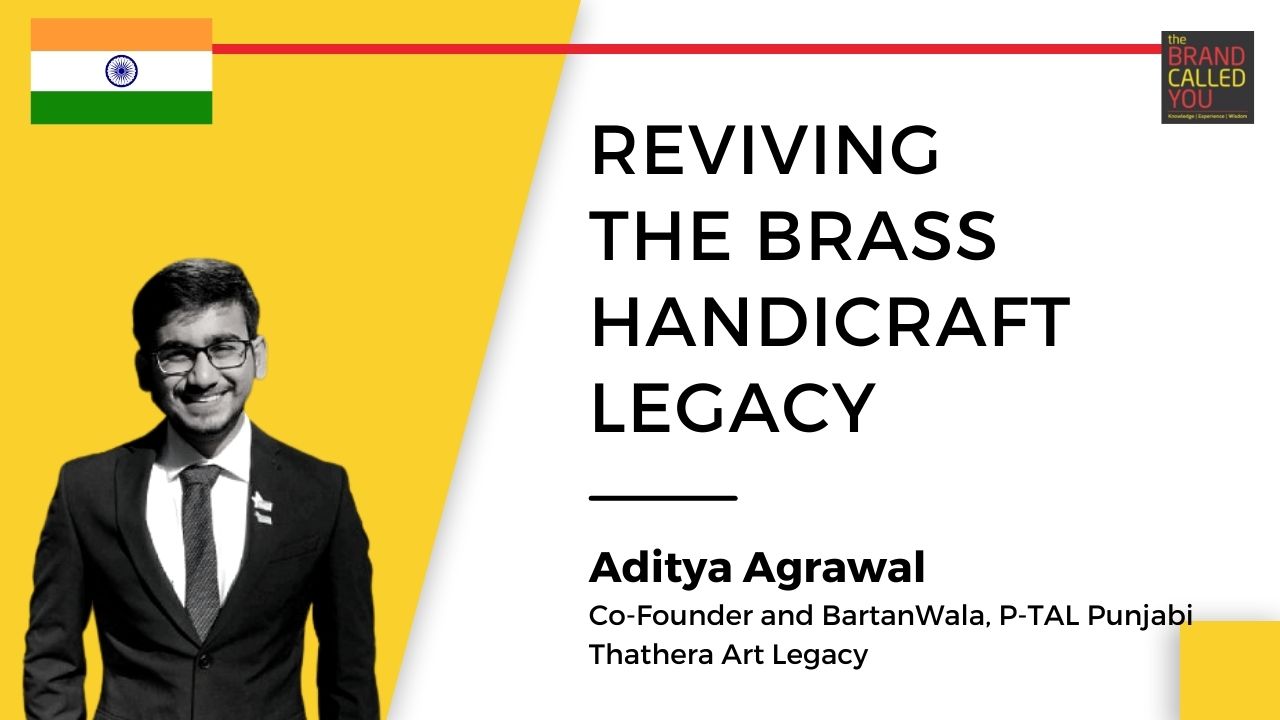Aditya Agrawal, Co-Founder, and BartanWala, P-TAL Punjabi Thathera Art Legacy
Aditya Aggarwal is the co-founder of PTAL – Punjabi Thathera Art Legacy (commonly pronounced as “peetal”, which is the Hindi word for brass). He is the former director of Enactus at SRCC. Aditya was also the global ambassador of the HSBC Asia Pacific business case.
Podcast
Overview
This episode brings you the story of a young boy, who decided to support a declining craft form and the craftsmen after he discovered them during a college project.
Our guest for today, Aditya Aggarwal, is the co-founder of PTAL – Punjabi Thathera Art Legacy (commonly pronounced as “peetal”, which is the Hindi word for brass). He is the former director of Enactus at SRCC. Aditya was also the global ambassador of the HSBC Asia Pacific business case.
About PTAL – Punjabi Thathera Art Legacy
Aditya tells us that while he was in Sriram College of Commerce, he was working on a college project in 2018. As he and his team were working, they came across a particular community in Punjab that was practicing the ‘Thathiyaar’ craft form. Aditya came to know that they are India’s only UNESCO-listed craft form.
Aditya tells us that the craft form was on the verge of extinction as only twenty families were involved in this craft form in 2018. This is why UNESCO was also planning on removing it from the list. The Thathera artisans were being exploited by society as they were not being paid well.
Seeing this, Aditya with his team decided to intervene. They formed the brand to bring this craft to the main market. They provided newer designs to the artisans that could fit the modern market.
PTAL was started as a platform to connect with the masses. As PTAL intervened, they are now getting a good quality material to work with, newer and modern designs that fit the market with a 600% increase in income. Thus, the craft form was revived.
What makes the Thathera Art Legacy, a listed crat form for UNESCO
Aditya tells us that the Thathera is a small community-based in Jandiala Guru, a small village near Amritsar in Punjab. They have been practicing this artform since the Maharaja Ranjit Singh era. After being impressed by the beauty of this craft form, UNESCO listed it under the list of Intangible Cultural Heritage in 2014.
How is brass good for us?
Talking about brass, Aditya tells us that brass is an alloy of zinc and copper. Both metals have amazing health benefits. According to Ayurveda, brass is the best metal to cook in. It allows the natural juices to come out of the food which gives it a better flavor. It is naturally non-stick too.
How do the small artisans get access to brass?
Aditya tells us that their aim was to do a holistic development of the community. It was because when they discovered the Thathera artisans, they found out that they did not have any knowledge of how to price their products, designs, etc.
Aditya provided them the pure quality of brass with the ISI mark so that the health benefits are not compromised. They also helped them with the products and designs that could fit the market.
Building a Handicraft Brand
Aditya tells us that building a Handicraft brand can be quite challenging when the machine-made alternatives are available in the market for much cheaper prices. So they had to educate the customers extensively on how their product is better.
They were taking pains to tell the customers what makes the price rise when the product is hand-made. Aditya tells us that during the pandemic, they started to share the stories of their craftsmen on their social media pages to connect them with the customer. This created a positive impact on both the customers and the artisans.
How is Aditya helping to document the knowledge the senior artisans hold?
Aditya tells us that the brass handicraft art form is a legacy that needs to be preserved. They always try to engage the upcoming generation with the older artisans to make them learn the craft form. They have also developed a research paper containing the stories of these craftsmen.
They keep engaging with different publications to cover the stories of these individual artisans so that more and more people can know about it. They try to make the artisans as visible as possible so that their knowledge and experiences can be preserved.
Role of the local government in improving the lives of handicraft artisans
Aditya tells us that when the venture was started, the local government was quite supportive of this idea. He tells us that the District Commissioner there helped them in many ways like getting stalls at different exhibitions at concessional rates.
He feels that the local government can do this in other places as well. This not only supports the artisans to go to big exhibitions and fairs to sell their products but also allows them to interact with the customer and get their feedback.
Profile
Aditya Aggarwal is the co-founder of PTAL – Punjabi Thathera Art Legacy (commonly pronounced as “peetal”, which is the Hindi word for brass). He is the former director of Enactus at SRCC.
Aditya was also the global ambassador of the HSBC Asia Pacific business case.


